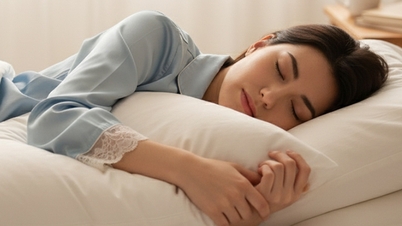Sleeping with a pillow, but choosing the wrong pillow, can be even more harmful. A pillow that is too high can also have a negative impact on the spine, according to the Times of India.
Below, sleep science coach David Rubin, who is working in the US, will explain clearly which sleeping positions should use pillows and when it is better to remove them.

For side or back sleepers, not using a pillow can cause the neck to become misaligned - leading to neck strain, back pain or muscle tension.
Illustration: AI
Sleeping Without a Pillow: What Happens?
According to health news site Sleep Doctor , sleeping without a pillow can help improve posture for stomach sleepers, but for back or side sleepers, this can be counterproductive.
For stomach sleepers, not using a pillow prevents the head from being raised too high, reducing stress on the neck and straightening the spine. In particular, if the pillow you are using creates an unnatural angle or is too high, removing the pillow can help reduce neck and back pain.
However, for people who sleep on their side or back, not using a pillow can cause the head to "fall down", causing the neck to become out of alignment - leading to neck fatigue, back pain or muscle tension.
Not having a pillow can cause the airway to relax less, increasing the risk of snoring or worsening sleep apnea.
In people with acid reflux, pillows often help elevate the head and reduce acid reflux; removing the pillow can make symptoms worse. So consider your individual health situation, according to Sleep Doctor .
The right choice for each sleeping position
Stomach sleeping: This is the only position that many experts say should not use a pillow because a high pillow can easily push the neck up too far.
Sleeping on your back: Without a pillow, your head can easily fall backward, putting pressure on your neck. In this case, a low pillow or a light support can help maintain the natural curve of your neck.
Side sleeping: This is a fairly common position, but without a pillow there will be a gap between the neck and the mattress, causing the neck to bend to one side, causing muscle tension and neck pain.
So, whether or not to use a pillow while sleeping depends on your sleeping position, neck and back structure, and your comfort, according to Sleep Doctor.
If you're transitioning to sleeping without a pillow, take it step by step:
- Start with a lower pillow or fold a blanket to make a softer pillow.
- Monitor your body's response, if you feel neck or back pain, you should go back to using a suitable pillow.
- Always choose a medium firm mattress for better body support.
- People with sleep apnea, acid reflux, or spinal conditions should consult their doctor before making any changes.
Ultimately, the most important thing is not whether or not to use a pillow, but to keep the neck, head and spine aligned, to maximize the benefits of sleep without causing harm.
Source: https://thanhnien.vn/rot-cuoc-nen-ngu-co-goi-hay-khong-goi-cau-tra-loi-tu-chuyen-gia-185251007230111016.htm












































































































Comment (0)